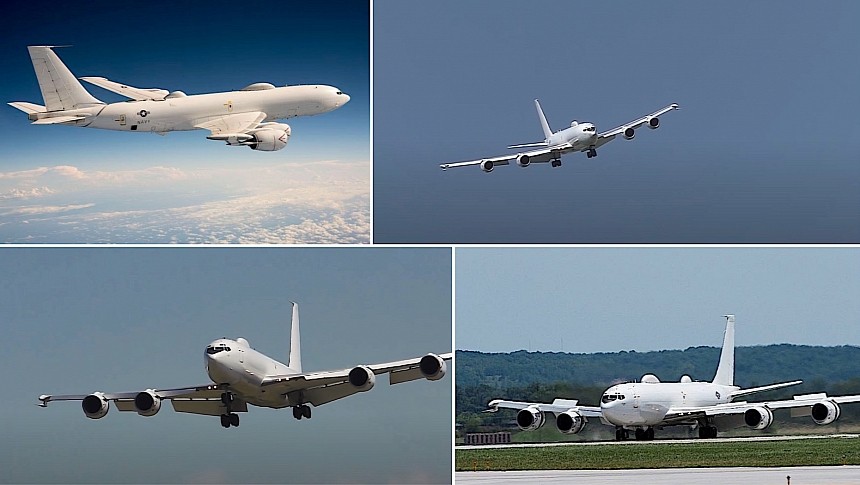We're possibly living the most dangerous days for global peace, with nations all over the planet barking at each other for reasons that at times seem trivial. And given how some of the nations now displaying an aggressive stance are equipped with nuclear weapons, the dangers are serious indeed.
Back in the spring of last year, at about the same time Russia rolled its tanks over Ukraine's border, the American military decided it's time for the nation's nuclear command and control capabilities to get a well deserved overhaul. And the process started with the upgrading of something called the E-6B Mercury.
Introduced back in 1998 as a replacement for the EC-135 and derived from the Boeing 707, the plane is powered by four turbofan engines that take it to speeds of 600 mph (960 kph) and to altitudes of about 40,000 feet (over 12,000 meters). The maximum range of the plane is rated at 7,590 miles (12,144 km), and it can loiter for six hours at a time.
More important than its specs sheet is, however, the airplane's role. The Mercury has been designed as an airborne platform to be used for strategic communication missions, being responsible for "reliable and endurable airborne command, control and communications in support of the President, Secretary of Defense and United States Strategic Command."
For it to be able to ensure comms between the National Command Authority (NCA) and American forces, the plane needs to be equipped with the most modern hardware. And that can only be achieved through constant upgrades.
The most recent one, called for ever since last year, is named Block II, and targets six major modifications. What they are exactly was not disclosed, but the U.S. Navy, the branch operating the planes, says they are meant to improve all of the Mercury's communication and control functions.
The company tasked with upgrading the E-6B under a $111 million contract is Northrop Grumman. Having begun work on the first aircraft about a year ago, the defense contractor said this week the first Block II Mercury has already been sent back to its home base, Oklahoma's Tinker Air Force Base.
One year to upgrade a single plane may seem like a lot, but Northrop, pushed by the Navy, plans to cut that down to just six months. Work is being performed at the company's Aircraft Maintenance and Fabrication Center in Lake Charles. A second Mercury has already reached the assembly lines, which are to be consolidated for future work on more such machines.
There is no estimate as to when work on all the plane of this kind (there are 16 of them in operation) are scheduled to end, but it probabl won't be very long, especially given the current state of the world.
Introduced back in 1998 as a replacement for the EC-135 and derived from the Boeing 707, the plane is powered by four turbofan engines that take it to speeds of 600 mph (960 kph) and to altitudes of about 40,000 feet (over 12,000 meters). The maximum range of the plane is rated at 7,590 miles (12,144 km), and it can loiter for six hours at a time.
More important than its specs sheet is, however, the airplane's role. The Mercury has been designed as an airborne platform to be used for strategic communication missions, being responsible for "reliable and endurable airborne command, control and communications in support of the President, Secretary of Defense and United States Strategic Command."
For it to be able to ensure comms between the National Command Authority (NCA) and American forces, the plane needs to be equipped with the most modern hardware. And that can only be achieved through constant upgrades.
The most recent one, called for ever since last year, is named Block II, and targets six major modifications. What they are exactly was not disclosed, but the U.S. Navy, the branch operating the planes, says they are meant to improve all of the Mercury's communication and control functions.
The company tasked with upgrading the E-6B under a $111 million contract is Northrop Grumman. Having begun work on the first aircraft about a year ago, the defense contractor said this week the first Block II Mercury has already been sent back to its home base, Oklahoma's Tinker Air Force Base.
One year to upgrade a single plane may seem like a lot, but Northrop, pushed by the Navy, plans to cut that down to just six months. Work is being performed at the company's Aircraft Maintenance and Fabrication Center in Lake Charles. A second Mercury has already reached the assembly lines, which are to be consolidated for future work on more such machines.
There is no estimate as to when work on all the plane of this kind (there are 16 of them in operation) are scheduled to end, but it probabl won't be very long, especially given the current state of the world.







